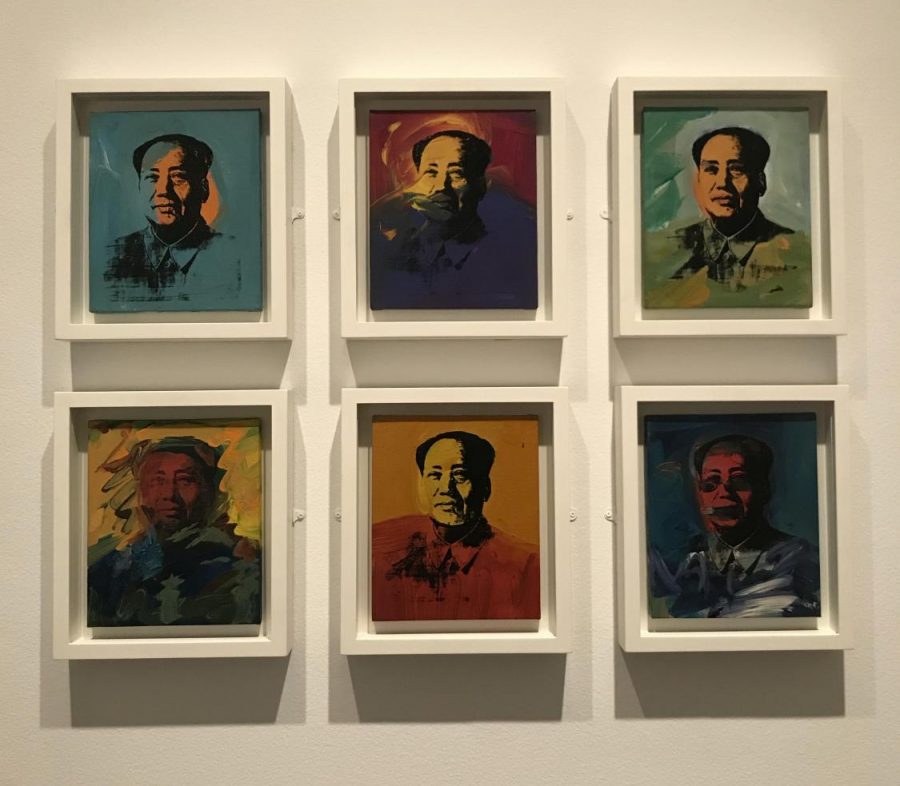Are We Home Yet?
CLEO PAPADOPOULOS/THE OBSERVER
Many Mao. Andy Warhol’s “Mao” pieces were on display at the Met Breuer as part of the Home Is a Foreign Place exhibit.
October 2, 2019
Art-lovers and media enthusiasts alike can be engaged by the enrapturing exhibition on at the Met Breuer, located just on the other side of Central Park at 75th Street and Madison Avenue. Easily accessible and running through June 21, 2020, Home Is a Foreign Place houses artwork from Latin American, Middle Eastern, American, North African and South and Southeast Asian artists who explore the concepts of finding one’s home and place in an ever-changing and interconnected world. It is truly an exhibition that speaks to the world we live in today.
Home Is a Foreign Place is like no other exhibition you will ever see. Bruce Nauman, Adriana Varejao, Andy Warhol and Walid Raad are among some of the prominent artists whose works are showcased in this exhibit; their pieces reflect the hardships, experiences and memories brought forth by different influential events that occurred during their lives — events like war, migration and economic change. These works allow viewers to contemplate their place in the world and what really constitutes home.
As soon as I entered the exhibition, I came face to face with a massive wall displaying, among others, one art piece that drew my attention immediately: a completely whitewashed wooden American flag created by Jasper Johns. This piece was a challenge to how a viewer normally perceives the American identity. The flag is devoid of color; there is no red, white or blue, and because of that, it makes people question their understanding of national identity. Who are we if we are not red, white and blue? What makes us Americans? These are complex questions to pose in today’s world, and the exhibit allows viewers to think outside the box.
Johns’s piece was not the only one to provoke contemplation about who I am and where and how I fit in. Halfway through the exhibit, an artwork by Robert Smithson titled “Mirrored Ziggurat” had a tremendous personal effect on me. This piece takes the shape of a pyramid entirely composed of layered mirrors. As I moved around the artwork, I saw my reflection and that of the gallery surrounding me. I immediately realized that no two people could ever have the same experience while looking at this piece. Each person’s experience depends on their position in relation to sculpture, so it will always be different — just like life!
“Mirrored Ziggurat” brings to mind people’s relationship with movement and space and brings to light the belief that they change as they move from place to place. It allows people to see that the environment in which they find themselves is crucial to shaping who they are, what they see and how they are seen by others. Smithson’s work delineates that one’s place in this world is subject to their displacement, and moving around inevitably changes a person.
As students, we all come from different places, countries, backgrounds and experiences. Regardless of where we are from, we are all here at Fordham to learn new things, meet new people and create a home on this campus and in this city. This exhibition provides the opportunity to explore our relationship with our environment, allowing us to contemplate how we can acclimate ourselves to our surroundings and make a foreign place our home.

Mirrored Ziggurat is just one of the many pieces around the exhibit.













